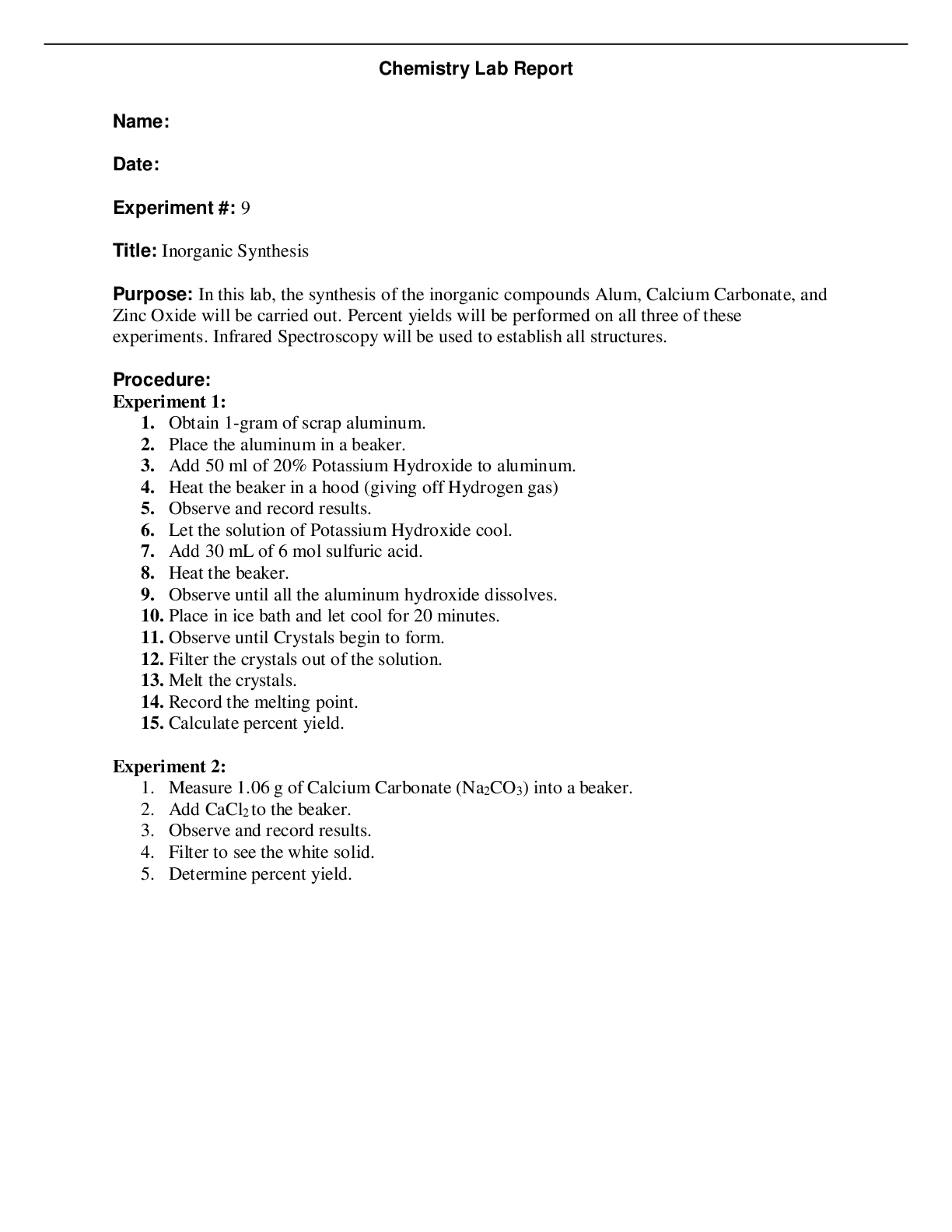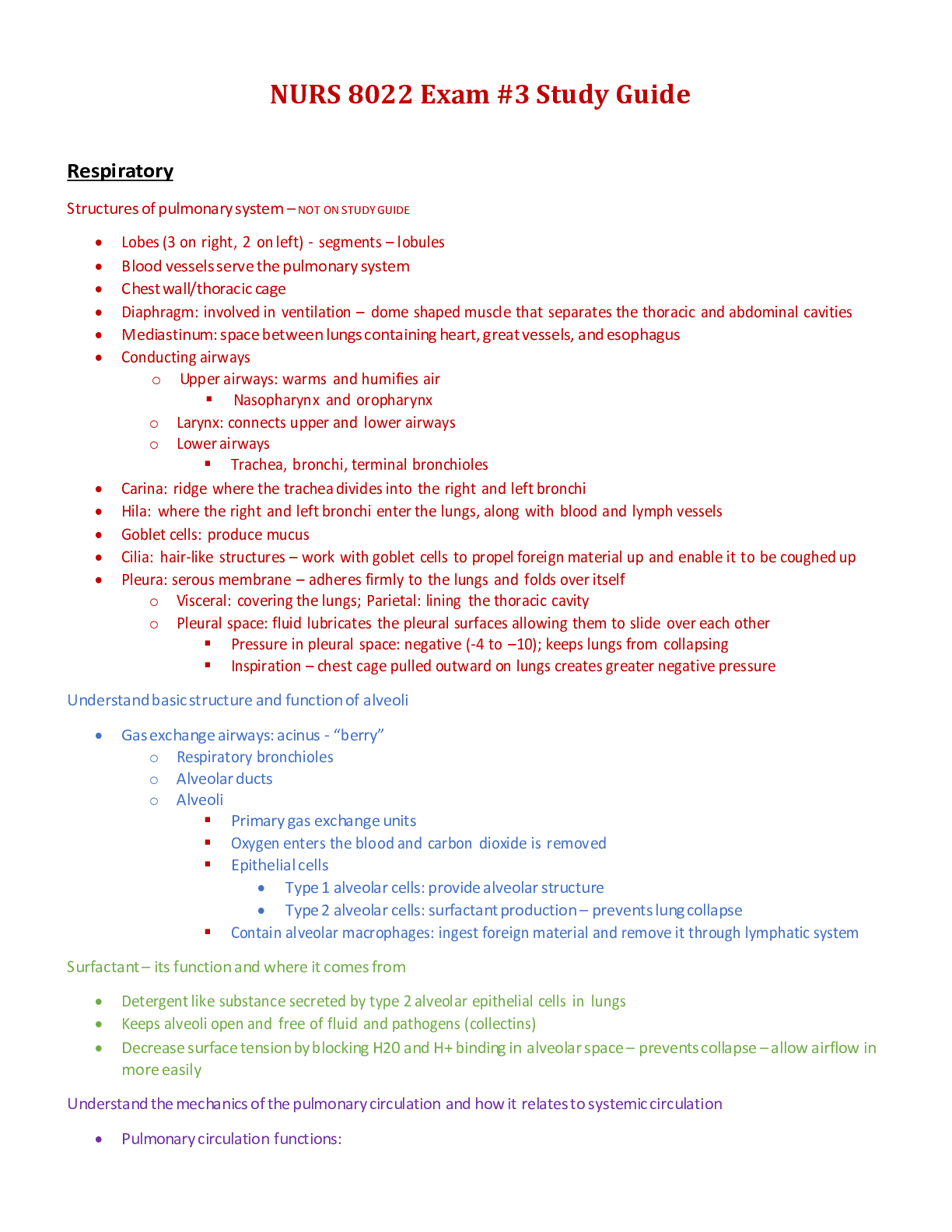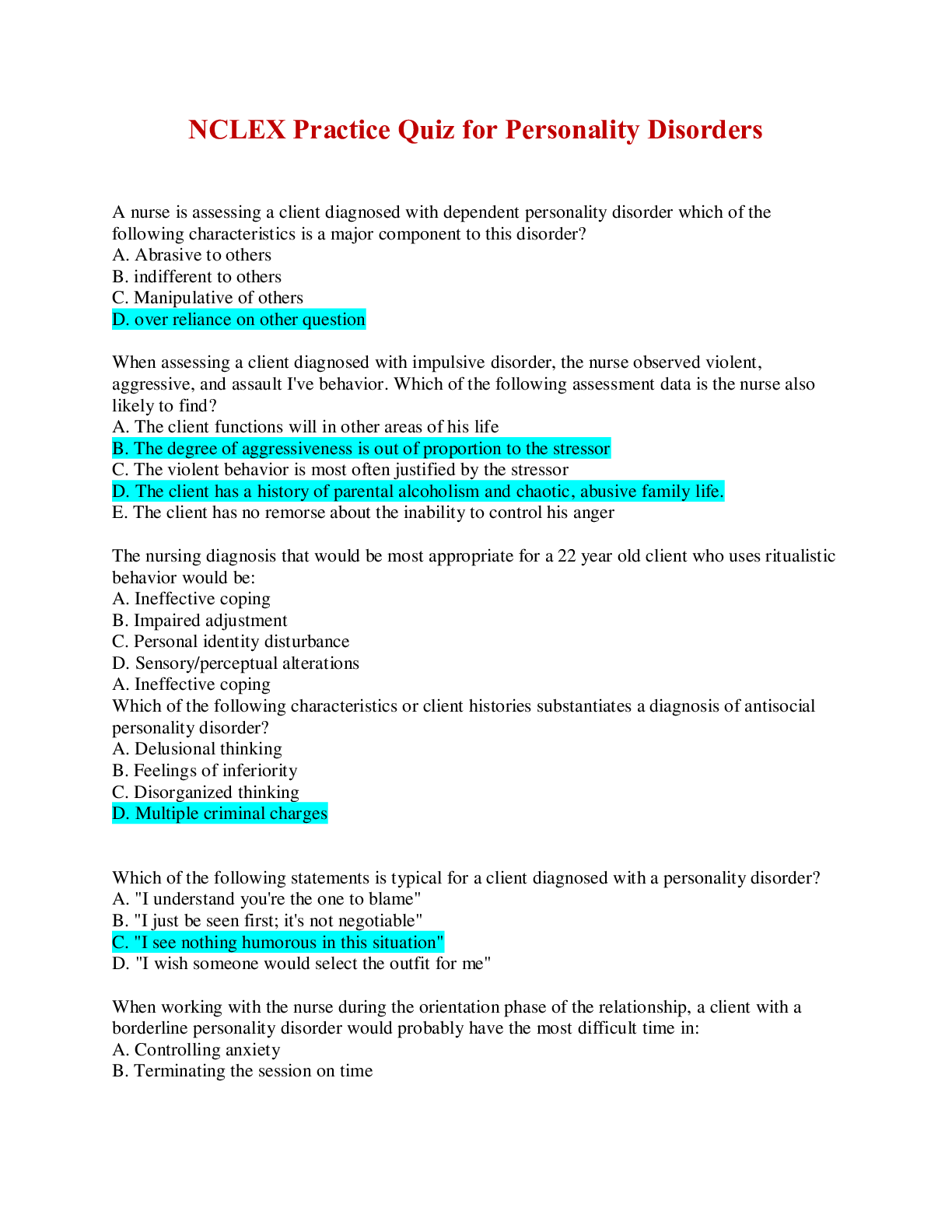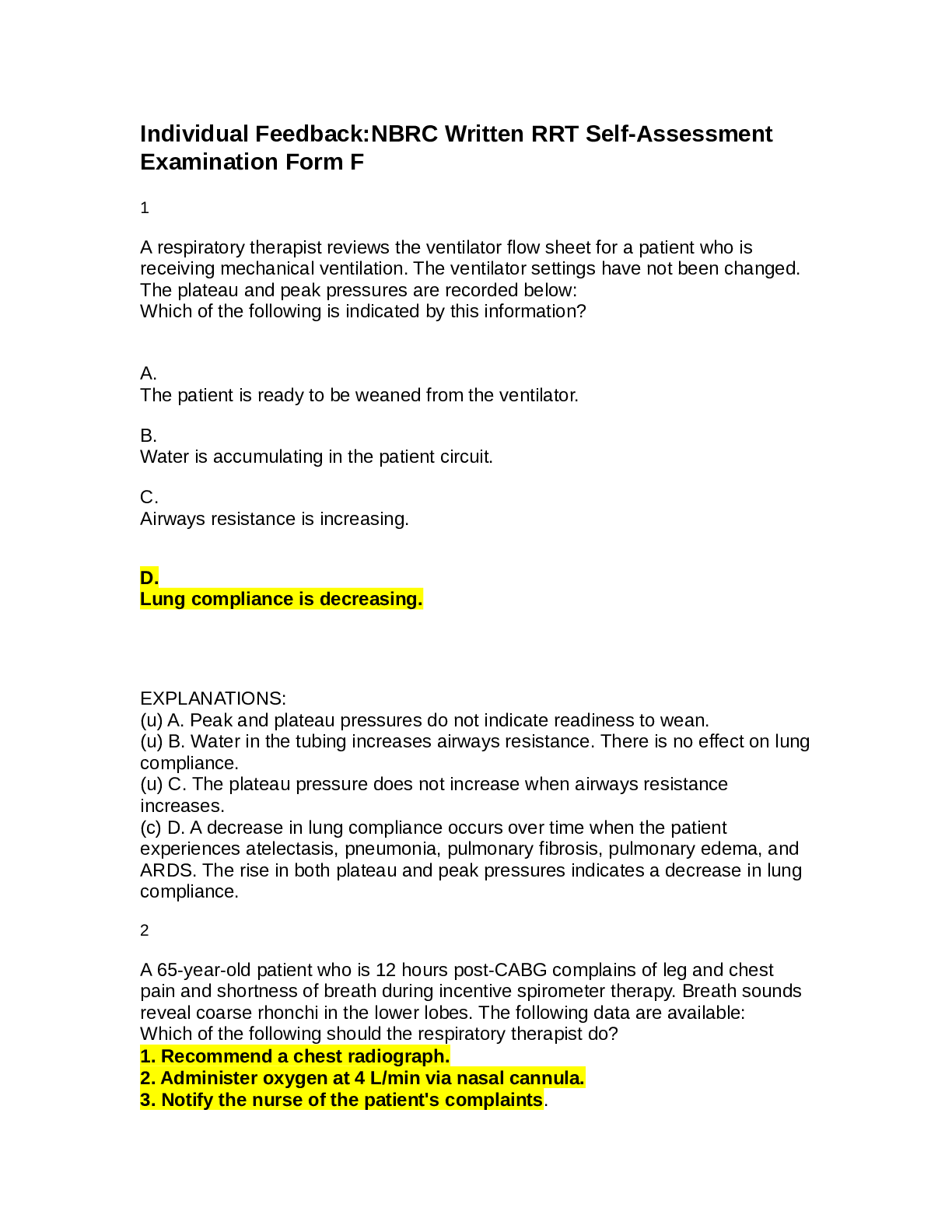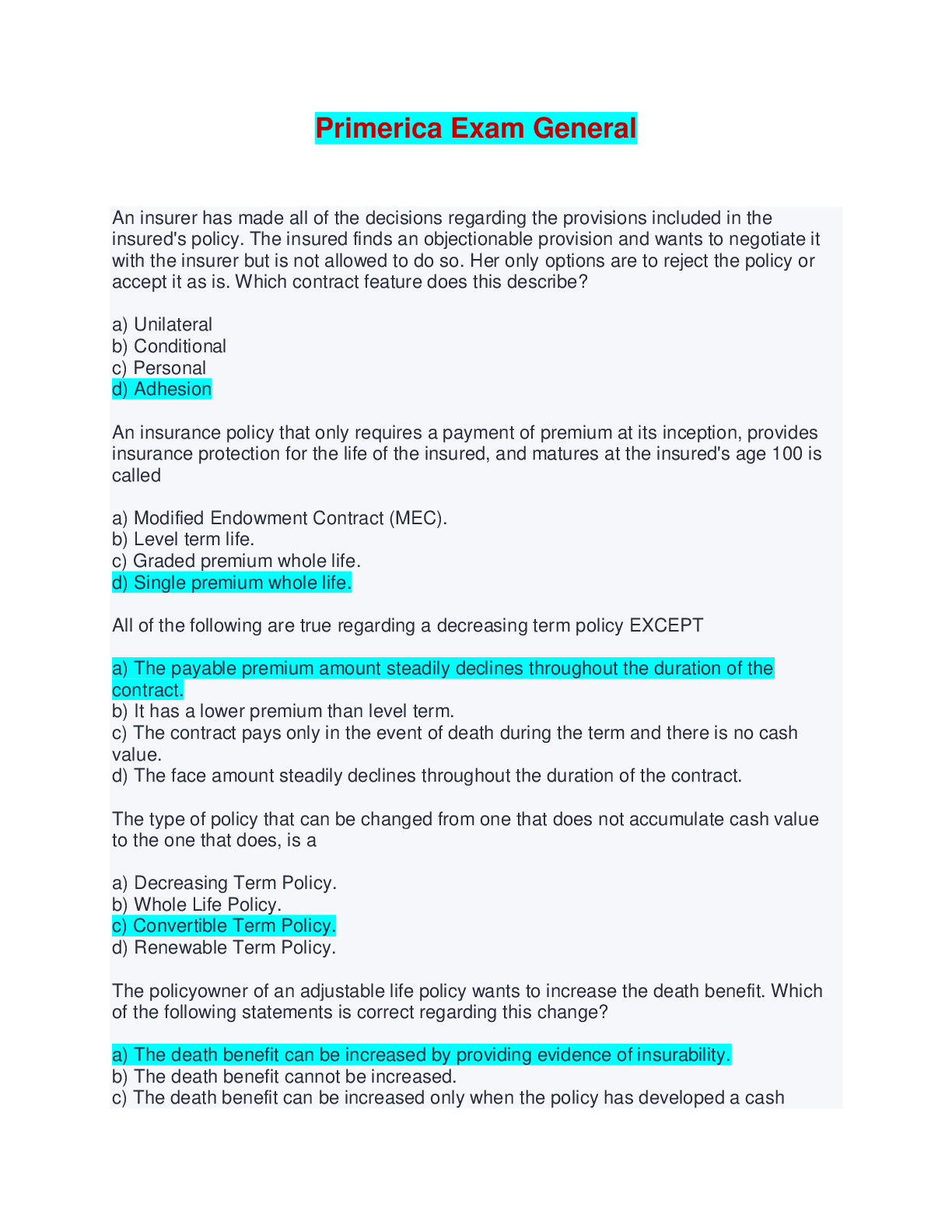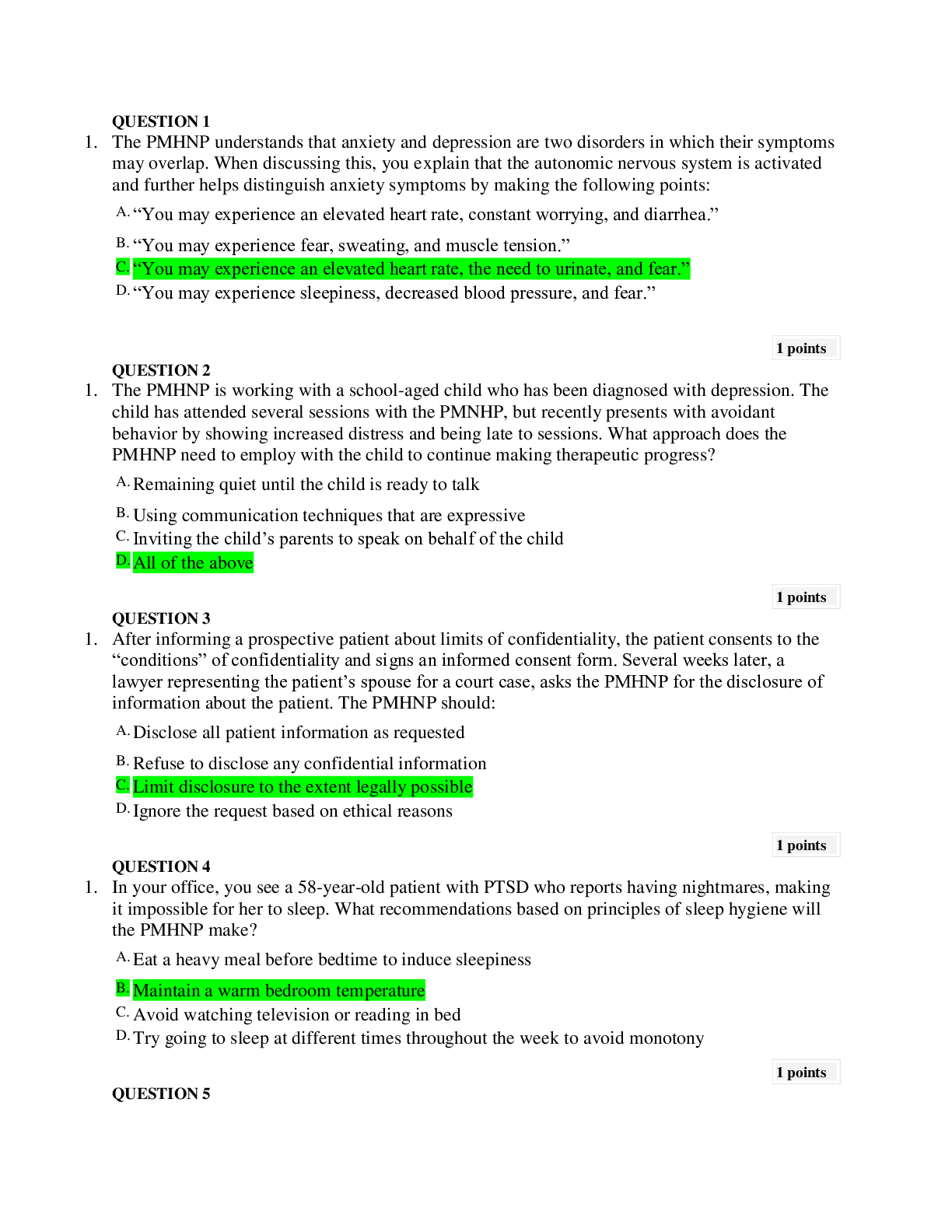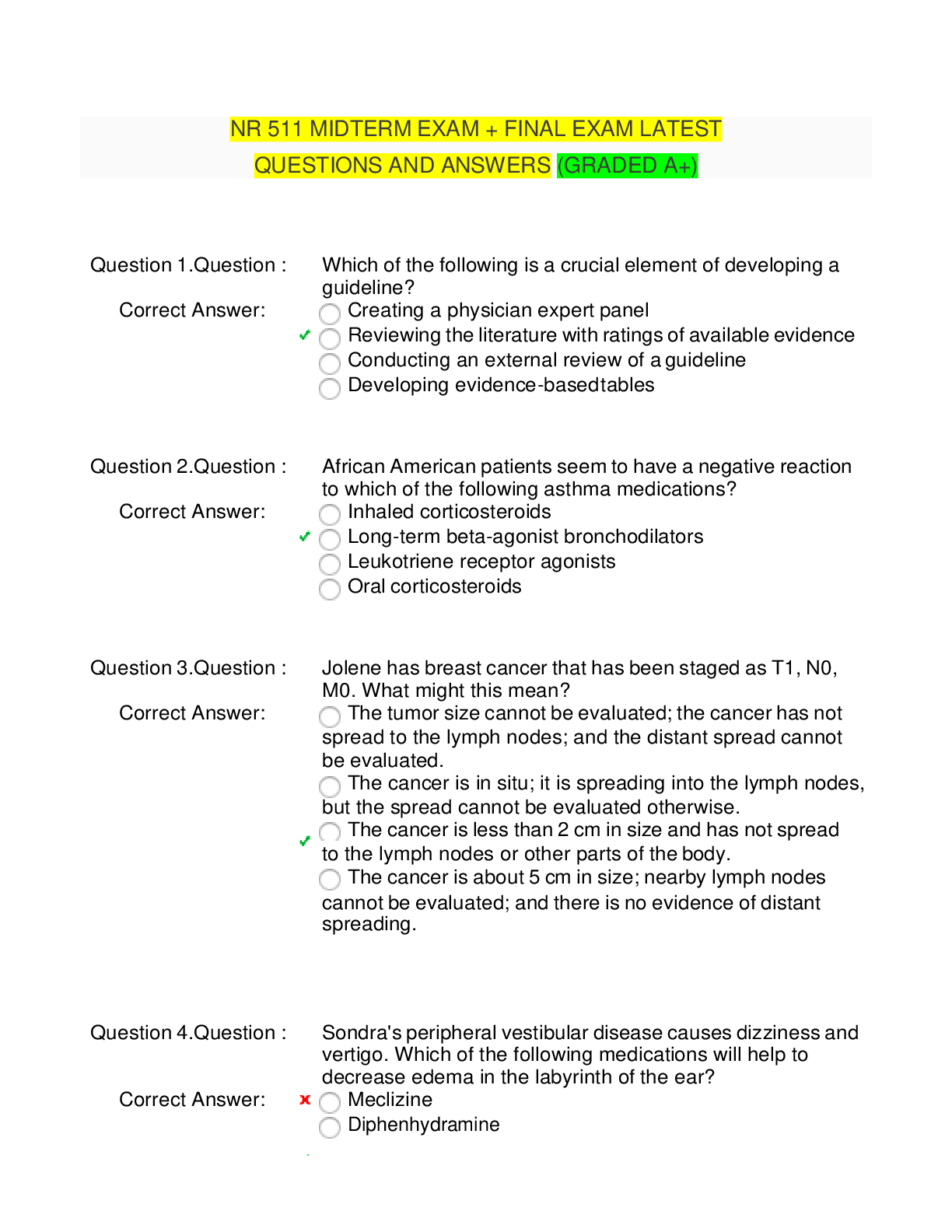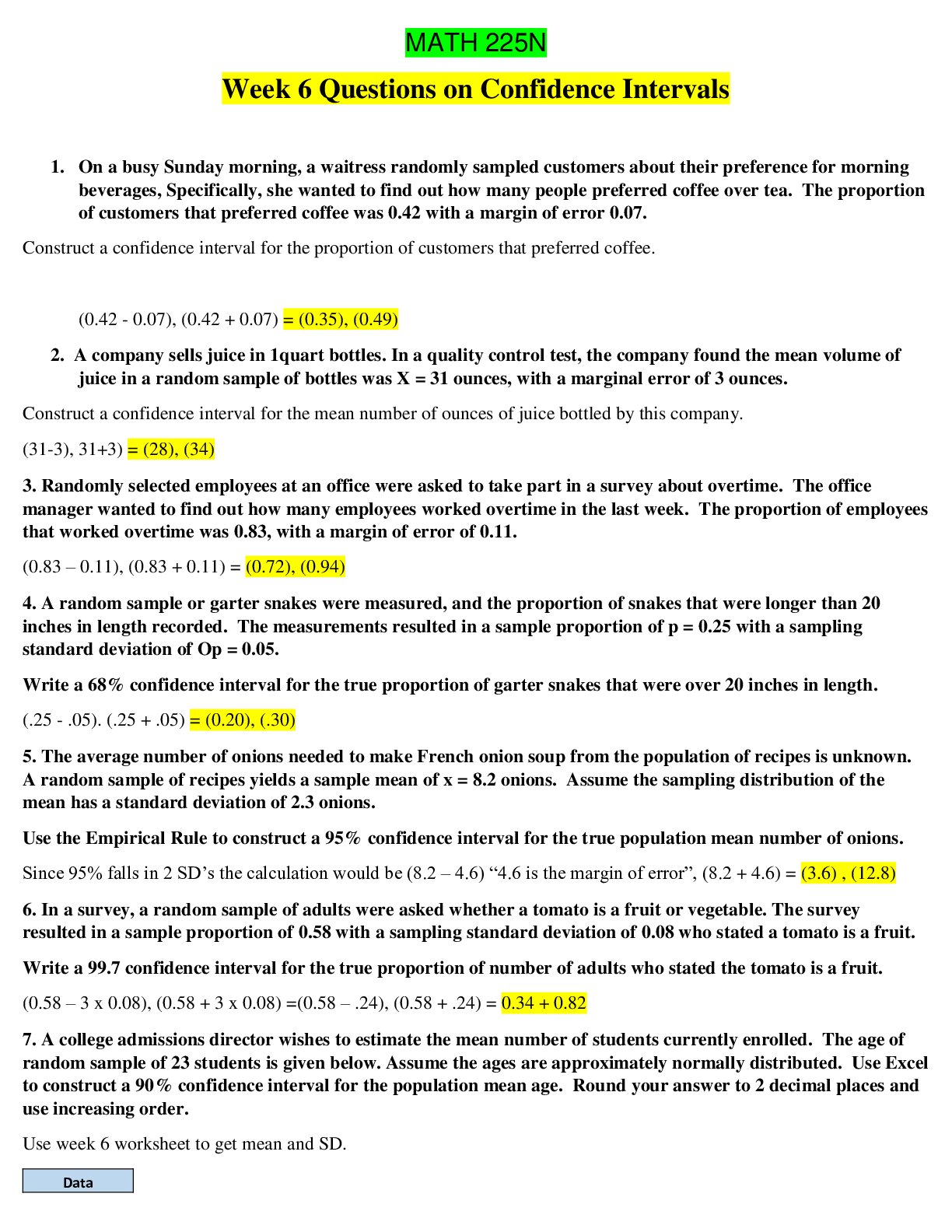Health Care > EXAM > CCE Practice Exam 1 - Questions and Answers (Complete Solutions) (All)
CCE Practice Exam 1 - Questions and Answers (Complete Solutions)
Document Content and Description Below
CCE Practice Exam 1 - Questions and Answers (Complete Solutions) Restlessness, psychomotor agitation, flushed face, diuresis, rambling speech, and muscle twitching are most suggestive of which of th... e following? A. Alcohol Withdrawal B. Caffeine Intoxication C. Cocaine Intoxication D. Hyperthyroidism Which of the following has been found to be the strongest predictor of Intellectual Disability with an unknown etiology? A. paternal health B. female gender C. large family size D. low birth weight A dimensional approach to diagnosis is based on a(n) ________ of attributes. a. quantification b. categorization c. exclusion d. dichotomization During the postpartum period, approximately _____ of women experience postpartum depression. A. 1 to 2% B. 10 to 15% C. 25 to 30% D. 45 to 50% A woman and her husband, who have been married for two years, come for marital therapy. The woman complains about her husband's lack of interest in family activities and in their 9-month-old child, his lack of affection toward her, and his lack of interest in sex. The husband, who says he did not want to come to therapy at all, states that he is a "loner," that he has always had few friends, and that he has never really been interested in his family. He seems quite aloof and emotionally unresponsive. Your tentative diagnosis is: a. Avoidant Personality Disorder. b. Schizoid Personality Disorder. c. Schizoaffective Disorder. d. Schizotypal Personality Disorder. Meta-analyses of research on the treatment of pediatric acute lymphoblastic leukemia with cranial radiation or chemotherapy have found that: A. either treatment alone is associated with decreased intellectual functioning and lower academic achievement. B. only cranial radiation is associated with decreased intellectual functioning and lower academic achievement. Incorrect C. only chemotherapy is associated with decreased intellectual functioning and lower academic achievement. D. they are associated with decreased intellectual functioning and lower academic achievement only when used in combination Use of which of the following substances is NOT likely to produce a Substance-Induced Psychotic Disorder? A. alcohol B. cannabis C. cocaine D. opioids John Conger (1956) offered the tension-reduction model of alcohol consumption as an explanation for: A. satiation. B. habituation. C. addiction. D. tolerance. The most likely DSM-5 diagnosis for a person who experiences genital pain during sexual intercourse that causes significant distress and cannot be better explained by a non-sexual mental disorder, relationship distress, or a medical condition is which of the following? A. Dyspareunia B. Vaginismus C. Genito-Pelvic Pain/Penetration Disorder D. Other Specified Sexual Dysfunction Cataplexy is often triggered by which of the following? A. smells associated with a traumatic event B. physical fatigue C. strong emotions D. stimuli associated with a feared object or event Alcohol Withdrawal is characterized by: a. dysphoric mood, vivid dreams, insomnia or hypersomnia, and increased appetite. b. hand tremor, insomnia, hallucinations, and seizures. c. incoordination, nystagmus, impaired memory, and mood lability. d. dysphoric mood, pupillary dilation, insomnia, and fever Your new client, a college freshman, says she sometimes has an "out of body" experience in which she is watching what she is doing from outside herself. She describes a recent experience in which she was in her dorm room writing a paper when she realized she couldn't feel her fingers on the computer keyboard or her feet on the floor and then suddenly felt like she was watching herself from the ceiling. The client says that these episodes make her feel like she's "going crazy" and are interfering with her ability to attend class and complete course assignments. The client's symptoms are most suggestive of a DSM-5 diagnosis of: A. Delusional Disorder B. Dissociative Fugue C. Depersonalization/Derealization Disorder D. Depersonalization Disorder As described in the DSM-5, which of the following are symptoms of Stimulant Intoxication? A. nystagmus, numbness, and muscle rigidity B. blurred vision, tremor, and depressed reflexes C. pupillary dilation, nausea, and muscular weakness D. fatigue, increased appetite, and vivid dreams As described by Sue and Sue (1999), "playing it cool" and "Uncle Tom Syndrome" are: A. signs of an internal locus of control. B. survival mechanisms. C. characteristics of the immersion-emersion stage of racial/cultural identity development. D. signs of functional (versus cultural) paranoia. Data published by Hans Eysenck in 1952: A. confirmed the effectiveness of behavioral treatments for a variety of psychological disorders. B. confirmed the "Dodo bird" hypothesis, which predicts that various types of therapy are equally effective for a variety of psychological disorders. C. challenged the notion of "spontaneous remission." D. challenged the effectiveness of conventional psychotherapeutic interventions. Which of the following is a challenge that may arise from mandating Evidence Based Therapies? A. The financial cost of training all of the individuals needed. B. The limited number of trainers with which to prepare those that are gaining skills in Evidence Based Therapies. C. The limited number of Evidence Based Trainings. D. The varied type and intensity of training that differs across regions. __________ described "personal constructs" as bipolar dimensions of meaning that determine how a person perceives, interprets, and predicts events. A. William Glasser B. George Kelly C. Victor Frankl D. Fritz Perls In their study of outpatient mental health services in Los Angeles County, Sue et al. (1991) found that, while clients from all groups showed improvement at the end of therapy, __________ had the best outcomes. A. African Americans B. Anglo Americans C. Asian Americans D. Hispanic Americans Manuel is a 21-year old college student who moved to the United States from Mexico with his family when he was four years old. Manuel has many Anglo friends at school and usually dates Anglo women, but, at home, he speaks Spanish and participates in the cultural traditions practiced by his family. When asked about his ethnic identity, Manuel says, "I'm American and Hispanic, but I guess I consider myself mostly Hispanic." Manuel is best described as: A. fused. B. separated. C. assimilated. D. bicultural. In the book, A Theory of Multicultural Counseling and Therapy, Sue, Ivey, and Pedersen (1996) describe three multicultural counseling competencies. These are: A. ability, knowledge, and sensitivity. B. flexibility, sensitivity, and awareness. C. awareness, knowledge, and skills. D. self-awareness, expertise, and strategies. In their meta-analysis of research evaluating psychotherapy outcomes for children and adolescents, Weisz and his colleagues (1995) obtained the largest effect size for: A. female children. B. male children. C. female adolescents. D. male adolescents. Bateson, Jackson, Haley, and Weakland (1956) identified double-bind communication as an etiological factor for which of the following disorders? A. Anorexia B. Schizophrenia C. Antisocial Personality Disorder D. Narcissistic Personality Disorder Family therapy is probably contraindicated in which of the following situations? A. The presenting problem involves long-term marital conflict. B. Family members attribute their problems to one of the members. C. One of the family members has severe depression. D. One of the family members has anorexia or bulimia. Helms's (1995) White Racial Identity Development Model distinguishes between six statuses, with each status being associated with a different information processing strategy. For example, the "flexibility and complexity" strategy is characteristic of the __________ status. A. internalization B. integrative awareness C. reintegration D. autonomy Caplan (1970) distinguished between four types of mental health consultation. Which of the following is an example of the type he labeled "consultee-centered case consultation"? A. A consultant is hired by a colleague to resolve a diagnostic dilemma she is having with a current client. B. A consultant is hired by a school to help school administrators evaluate the effectiveness of an existing remedial program for at-risk students. C. A consultant monitors a support group for administrators to help them develop better interpersonal skills. D. A consultant helps a teacher acquire the behavior modification skills she needs to reduce disruptions in her classroom. Don Jackson, Murray Bowen, and a number of pioneers in the field of family therapy had a psychodynamic background, which they incorporated, to some degree, in their approach to family therapy. However, it is the psychoanalyst _______________ who is generally identified as the first to formally adapt and apply psychoanalytic principles to the understanding of the family. A. Nathan Ackerman B. Carl Whitaker C. Richard Stuart D. Robert Liberman When treating a couple in which the husband has physically abused his wife and it has been clearly determined that the abuse can be classified as instrumental (vs. expressive), the best initial approach is: A. to ensure that the husband and wife are physically separated and to provide them with separate therapy. B. to have the husband and wife sign a "no-violence contract" and to provide them with separate therapy. C. to have the husband and wife sign a "no-violence contract" and to provide them with conjoint therapy. D. to provide combined individual and group therapy for both the husband and wife. Dr. Nillson, a behavioral psychologist, is teaching clinical psychology at a university. She does not use, nor can she tolerate the use of, psychodynamic principles and interventions in psychotherapy. She refuses to teach psychodynamic therapy in her classes and actually makes fun of it in front of her students during informal gatherings. Her behavior is: A. unethical she has an obligation to provide accurate and objective information about the topic she is teaching. B. ethical she has the freedom of choice to teach whatever she wants in her classes. C. acceptable she would be poorly trained to teach psychodynamics and psychotherapy anyway. D. ethical but she should not be making fun of any psychological practice in front of her students Which of the following is most consistent with ethical requirements regarding publication credit for publications that are substantially based on a student's doctoral dissertation? A. Authorship credit must reflect each individual's relative contribution to the research project. B. Authorship credit must be mutually agreed upon by all individuals who contributed to the project. C. The student must be listed as first author except under exceptional circumstances. D. The student must always be listed as first author. An evaluation of a defendant's competence in a criminal court case is conducted to determine his/her mental status: A. at the time of the evaluation. B. at the time the crime was committed. C. at the time of the arrest. D. prior to committing the crime. According to the APA's Specialty Guidelines for Forensic Psychology (APA, 2012), accepting contingent fees for professional services in a legal proceeding: A. is acceptable. B. is acceptable only if the fees are "fair and equitable." C. should be avoided unless doing so does not interfere with the psychologist's objectivity. D. should ordinarily be avoided. You receive a court order requesting that you provide information about a 19-year-old client who is currently the defendant in a court case. You discuss the request with the client but he refuses to sign a waiver of confidentiality. You should: A. refuse to provide the court with the requested information until you obtain a waiver from the client. B. refuse to provide the court with the requested information until you obtain a waiver from the client's attorney or legal guardian. C. provide the court only with information that you believe will not be harmful to the client. D. provide the court with the requested information. A married couple's insurance provides reimbursement for individual therapy but not for marital therapy. The psychologist has determined, however, that marital therapy is the appropriate form of treatment for the couple. The psychologist should: A. treat them in individual therapy since it is covered by the insurance. B. bill for individual therapy while treating them as a couple. C. appeal to the insurance company for coverage for marital therapy. D. none of the above A psychologist who obtained a Ph.D. in organizational psychology wants to change her specialty to clinical psychology. To meet the requirements of APA's guidelines regarding a change in specialty, the psychologist must: A. complete an internship in clinical psychology under the supervision of a licensed clinical psychologist. B. complete appropriate doctoral-level classes and supervised post-doctoral training. C. obtain a second Ph.D. in clinical psychology from an accredited university or professional school. D. obtain appropriate supervision of her clinical practice. Murphy, DeBernardo, and Shoemaker's (1998) survey of psychologists about the effects of managed care on their professional practice found that the most frequently cited negative effect was: A. increased demands due to utilization review. B. some panels being closed to psychologists. C. income decline due to decreased volume of patients. D. increased need for supervision. Dr. D. Centt is conducting a study to investigate the effectiveness of a brief behavioral treatment for reducing self-mutilation in young women. The treatment involves 20 hourly sessions that will be administered once a week for 20 weeks. Dr. Centt randomly assigns 40 women with a history of self-mutilation to either the treatment group or the no-treatment control group. After women in the treatment group have completed only six sessions, he finds that the treatment has nearly eliminated their self-mutilating behaviors. In contrast, nearly all of the women in the control group report multiple incidents of self-mutilation since the study began. As an ethical psychologist, Dr. Centt's best course of action would be to: A. continue the study as long as the women in the control group signed informed consents at the onset of their participation. B. continue the study but offer the treatment to the women in the control group at the end of the study. C. discontinue the study and offer the treatment to the women in the control group immediately. D. try to get the results of the study published as soon as possible so that the effectiveness of the treatment is recognized. An insurance company is conducting a peer review and requests that you provide it with information about a current client whose fee is being paid by the company. In this situation, you are best advised to: A. provide the company with the requested information only if the client is willing for you to do so. B. provide the company with only that information you believe to be pertinent to the review. C. provide the company with relevant information after ensuring that it is aware of the need to maintain confidentiality. D. provide the company with the requested information because the client waived confidentiality when he/she signed the insurance form A colleague at the mental health clinic where you are employed tells you that one of his clients has admitted to sexually abusing his daughter. The colleague says he is not going to report the abuse since it was mild in nature and the client has expressed remorse, promised not to do it again, and is willing to continue therapy. In addition, he feels that reporting the abuse would be detrimental to the community since the client is a widely-known, well-respected person. You should: A. attempt to discuss the matter further with the colleague and encourage him to make a report to the appropriate child abuse reporting authority. B. file a complaint against the colleague with APA or the state licensing board. C. contact the appropriate child abuse reporting authority and provide them with information about the abuse and with the colleague's name. D. contact the appropriate child abuse reporting authority and provide them with information about the abuse but refuse to give them the colleague's name if they request it. In the context of managed health care, "gatekeeper" refers to the: A. peer review board. B. HMO. C. clinical supervisor. D. primary care physician. The Examination for Professional Practice in Psychology (EPPP) is best described as: A. a measure of basic knowledge of psychology. B. a predictor of job proficiency. C. an aptitude test. D. a way to protect the public from incompetent psychologists If an unconditioned stimulus is repeatedly presented just prior to a conditioned stimulus in order to replace an undesirable response with a more desirable one, which of the following will most likely occur? A. The target response will eventually be eliminated. B. The target response will be suppressed (but not eliminated). C. The target response will paradoxically increase. D. The target behavior will not change in frequency. Which of the following intermittent schedules of reinforcement produces the highest rate of responding and the greatest resistance to extinction? A. fixed interval B. fixed ratio C. variable interval D. variable ratio To reduce a five-year old's nighttime fear of the dark, the most effective treatment would be: A. coping self-statements and positive imagery. B. in vivo exposure with response prevention. C. stress inoculation. D. covert sensitization. When a person with an optimistic attribution style does poorly on an exam in a class he ordinarily does well in, that person will most likely say which of the following? A. I didn't study hard enough. B. I was unlucky. C. The teacher gave a very hard test this time. D. The teacher always grades on the curve. According to _______________, depression is attributable to deficits in self-monitoring, self-evaluation, and self-reinforcement. A. Bandura's self-efficacy model B. Rehm's self-control theory C. Seligman's learned helplessness model D. Swann's self-verification theory Thermal (temperature) biofeedback would be most effective as a treatment for: A. hyperventilation. B. Raynauds disease. C. stuttering. D. TMJ. The three overlapping stages of Meichenbaum and Jaremko's (1982) stress inoculation training are: A. formulation, problem focus, and termination. B. self-monitoring, self-evaluation, and self-reinforcement. C. cognitive modeling, overt instruction, and covert instruction. D. conceptualization, skills acquisition, and application. For the treatment of hypertension, biofeedback: A. is generally ineffective. [Show More]
Last updated: 3 weeks ago
Preview 5 out of 27 pages
Instant download

Loading document previews ...
Buy this document to get the full access instantly
Instant Download Access after purchase
Add to cartInstant download
Also available in bundle (1)
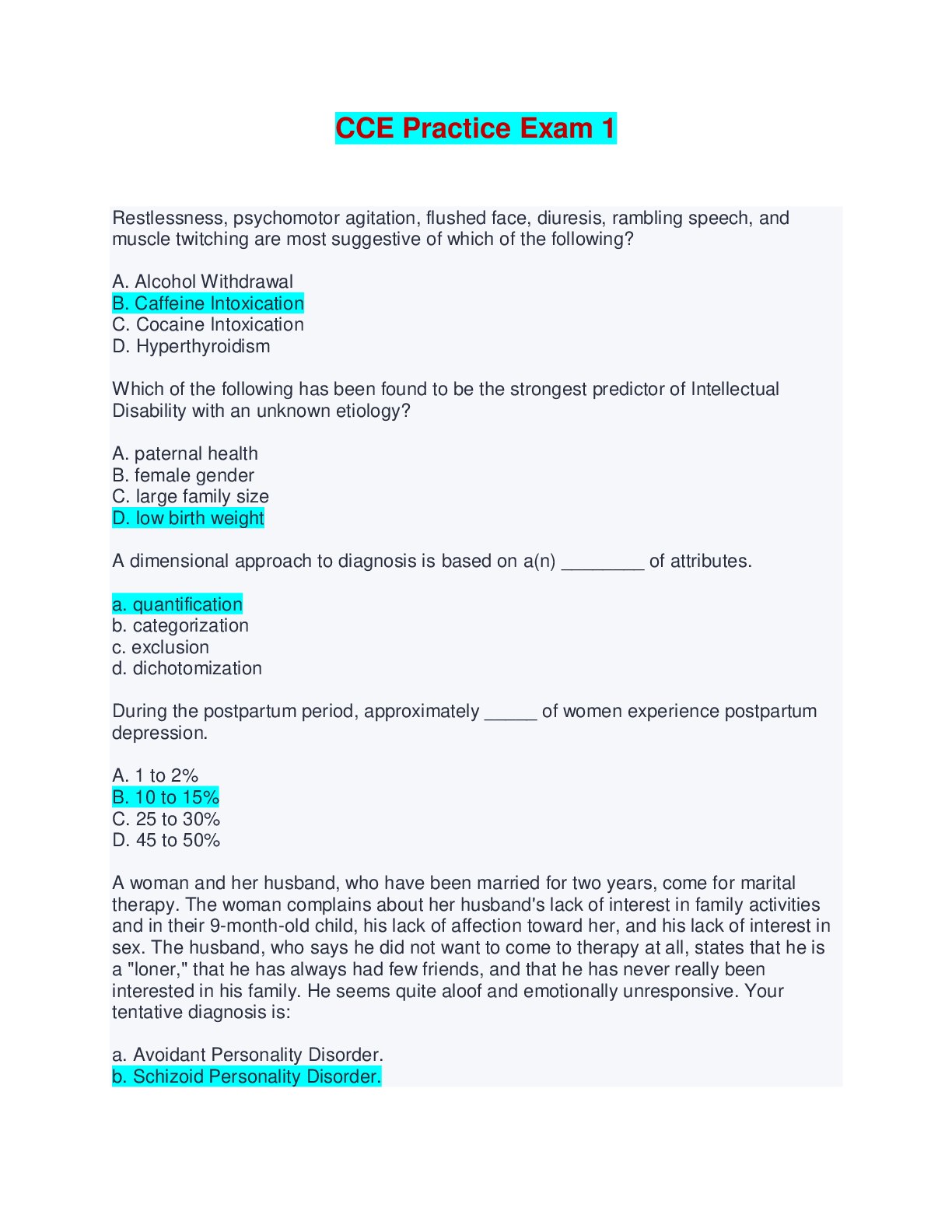
CCE PRACTICE EXAM 1 - 6 BUNDLE
CCE PRACTICE EXAM 1 - 6 BUNDLE
By Nurse Henny 2 weeks ago
$50
6
Reviews( 0 )
Document information
Connected school, study & course
About the document
Uploaded On
Jun 05, 2024
Number of pages
27
Written in
Additional information
This document has been written for:
Uploaded
Jun 05, 2024
Downloads
0
Views
5



